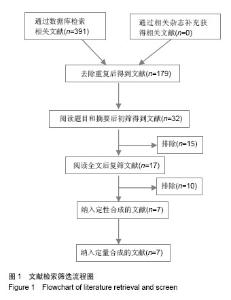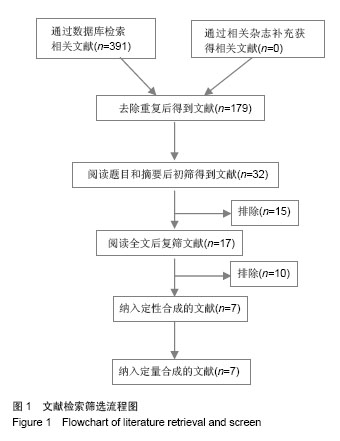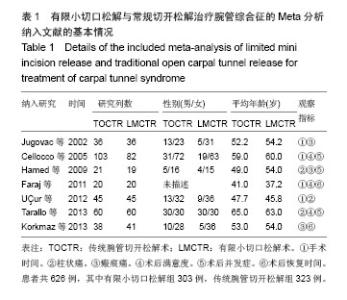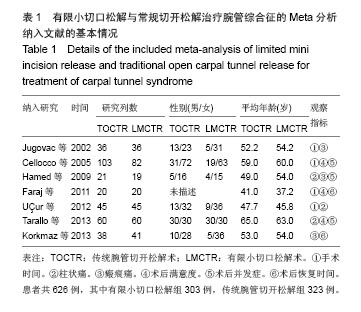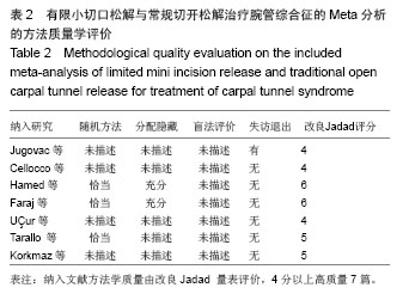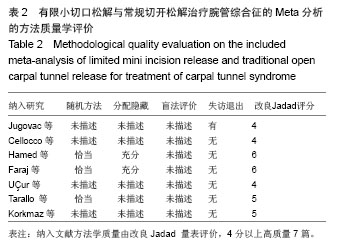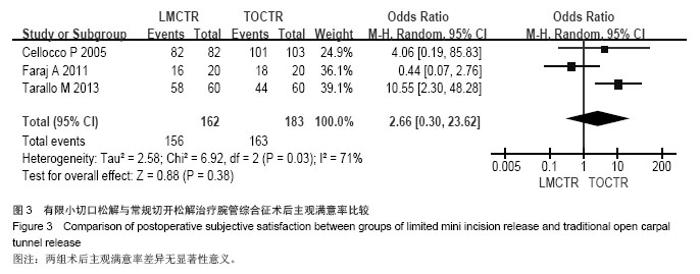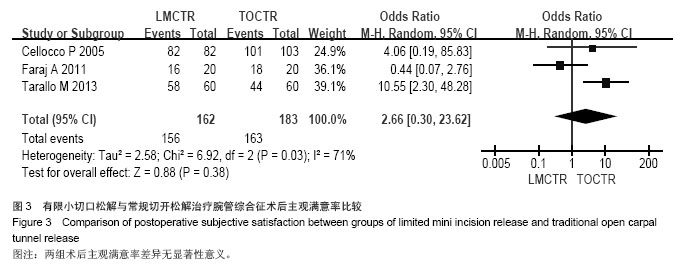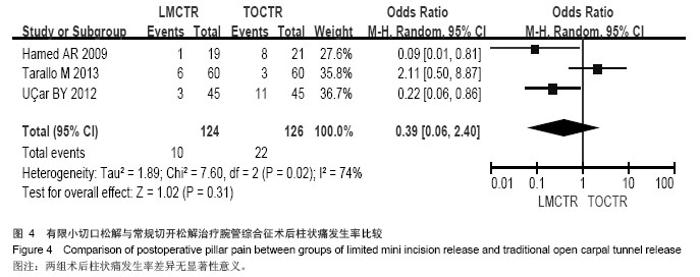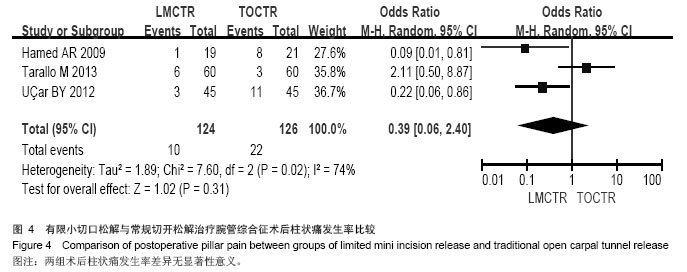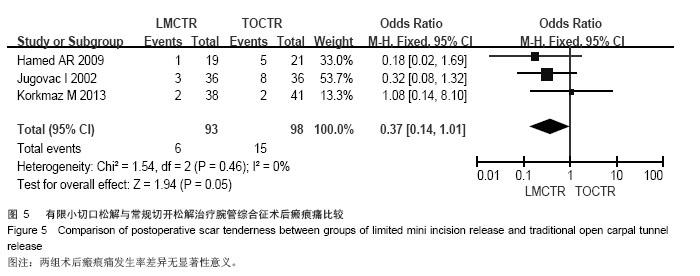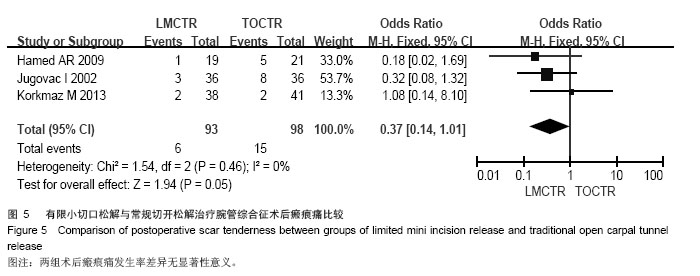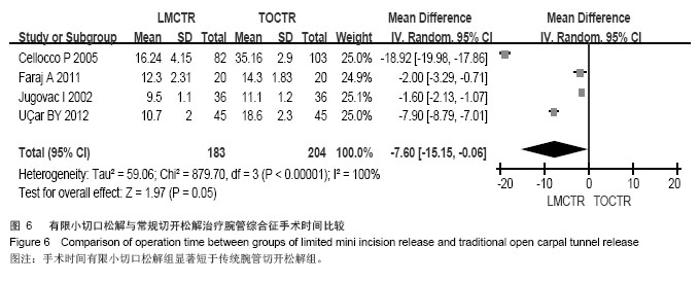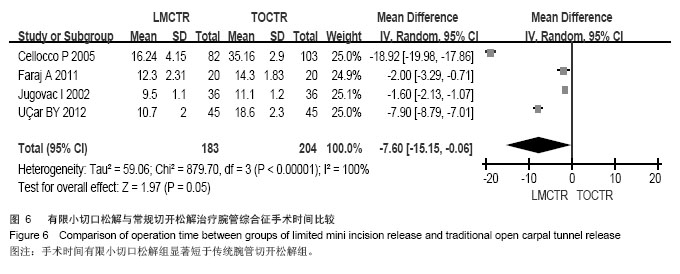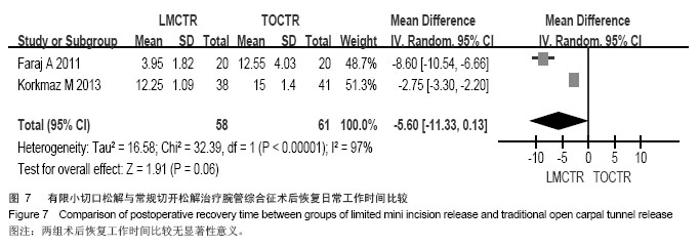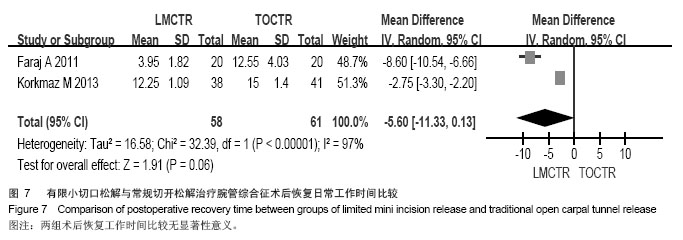Chinese Journal of Tissue Engineering Research ›› 2014, Vol. 18 ›› Issue (51): 8358-8364.doi: 10.3969/j.issn.2095-4344.2014.51.029
Meta-analysis of limited mini incision release and traditional open carpal tunnel release for treatment of carpal tunnel syndrome
Aikeremu Wupuer, Jiasharete Jielile, Aihemaitijiang Yusufu, Abulaiti Abula, Abuduheilili Maimaitiaili, Liu Ya-fei, Ayinazi, Huang Yong, Yang Peng-fei
- Department of Microsurgery and Reconstruction Surgery, the First Affiliated Hospital of Xinjiang Medical University, Urumqi 830054, Xinjiang Uygur Autonomous Region, China
-
Online:2014-12-10Published:2014-12-10 -
Contact:Jiasharete Jielile, Associate professor, Associate chief physician, Master’s supervisor, Department of Microsurgery and Reconstruction Surgery, the First Affiliated Hospital of Xinjiang Medical University, Urumqi 830054, Xinjiang Uygur Autonomous Region, China -
About author:Aikeremu Wupuer, Studying for master’s degree, Department of Microsurgery and Reconstruction Surgery, the First Affiliated Hospital of Xinjiang Medical University, Urumqi 830054, Xinjiang Uygur Autonomous Region, China -
Supported by:the National Natural Science Foundation of China, No. 81460337
CLC Number:
Cite this article
Aikeremu Wupuer, Jiasharete Jielile, Aihemaitijiang Yusufu, Abulaiti Abula, Abuduheilili Maimaitiaili, Liu Ya-fei, Ayinazi, Huang Yong, Yang Peng-fei. Meta-analysis of limited mini incision release and traditional open carpal tunnel release for treatment of carpal tunnel syndrome[J]. Chinese Journal of Tissue Engineering Research, 2014, 18(51): 8358-8364.
share this article
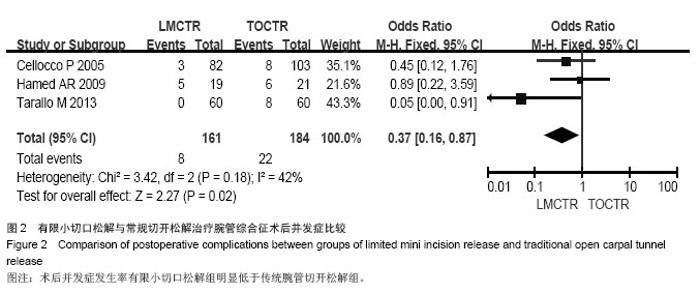
2.2 研究质量小结 纳入研究均有明确的纳入和排除标准。有4项研究未描述具体的随机方法,因此有选择性偏倚的中度可能性。有5项研究未描述分配隐藏,其余4个研究均正确使用了密闭信封,因此实施偏倚的可能性较小。由于外科手术的特殊性,纳入研究均未使用盲法,可能存在中度测量性偏倚。1项研究均有失访,描述了退出例数及理由,因此存在较高度损耗性偏倚。系统评价纳入的文献研究代表性尚好,各研究间具有较高的同质性,在年龄、性别比例、手术时间、手术方法、损伤严重程度等基线水平比较各研究间差异无显著意义。 2.3 系统评价结果 2.3.1 术后并发症发生率的评价 3个研究比较了有限小切口松解组与传统腕管切开松解组术后并发症发生率[15-16,19],共345例,其中接受有限小切口松解有161例,接受传统腕管切开松解有184例,对于术后并发症发生率,各研究间异质性较低(Ⅰ2=42%),采用固定效应模型,由图2可以看出2种手术方法的术后并发症发生率差异有显著性意义[OR=0.37;95% CI(0.16,0.87),P=0.02],术后并发症发生率有限小切口松解组明显低于传统腕管切开松解组。"
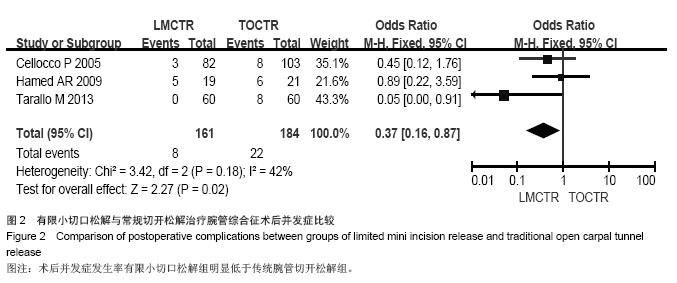
| [1]王玉发,陈俊,李玉祥,等.老年腕管综合征的病因学研究与临床诊治特点[J].中国实验诊断学,2011,15(3):536-537.
[2]婧嵌,史其株.腕管综合征治疗进展[J].国际骨科学杂志,2010, 31(5):282-284.
[3]吴鹏,虞聪.轻中度腕管综合征保守治疗进展[J]. 国际骨科学杂志, 2010;31(1):
[4]顾玉东,陈德松,史其林,等.腕管综合征128例分析[J].中华手外科杂志,2006;22(5):283 28526-28528.
[5]Trumble TE, Diao E, AbramsRA, et al Single -portal endoscopiccarpal tunnel release compared with open release : a prospective ,randomized trial.Bone Joint Surg Am.2002;84-A(7):1107-1115.
[6]赵宏,赵宇,田野,等.腕管综合征关节镜下手术与开放手术的疗效比较[J].中国医学科学院学报,2004,26:657-660.
[7]Wong KC, Hung LK, Ho PC, et al.Carpal tunnel release . Aprospective , randomized study of endoscopic versus limited -openmethods.J Bone Joint Surg Br,2003,85:863-868.
[8]Brown RA, Gelber manRH,Seiler JR,et al.Carpal tunnel release. A prospective, randomized assessment of open and endoscopicmethods. J Bone Joint Surg Am.1993; 75:1265- 1275.
[9]Hallock GG, Lutz DA.Prospective comparison ofminimal incision”open” and two-portal endoscopiccarpal tunnel release.Plast Reconstr Surg.1995; 941-946.
[10]Bromley GS.Minimal-incision open carpal tunneldecompression.J Hand Surg 1994;19A:119-20.
[11]Serra JM, Benito JR, MonnerJ. Carpal tunnelrelease with short incision. Plast Reconstr Surg 1997;99: 129-35.
[12]Lee WB, Strickland JW. Safe carpal tunnel releasevia a limited palmer incision. Plast Reconstr Surg1998;101:418-424.
[13]Jadad AR, Moore RA, Carroll D, et al.Assessing the quality ofreports of randomized clinical trials: is blinding necessary? Control Clin Trials.1996;17(1):1-12.
[14]Jugovac I, Burgi? N, Mi?ovi? V,et al. Carpal tunnel release by limited palmar incision vs traditional open technique: randomized controlled trial. Croat Med J. 2002;43(1):33-36.
[15]Cellocco P, Rossi C, Bizzarri F,et al. Mini-open blind procedure versus limited open technique for carpal tunnel release: a 30-month follow-up study. J Hand Surg Am. 2005; 30(3):493-499.
[16]Hamed AR, Makki D,Chari R,et al. Double-versus single-incision technique for open carpal tunnel release. Orthopedics. 2009; 32(10). pii: orthosupersite. com/view.asp?rID=43772.
[17]Adnan Abdilmajeed Faraj,Murshid Hamza Ahmed,Omar Ameen Saeed. A comparative study of the surgical management of carpal tunnel syndrome by mini-transverse wrist incisions versus traditional longitudinal technique European. Journal of Orthopedic Surgery & Traumatology. 2012:22(3):221-225.
[18]Uçar BY, Demirta? A, Bulut M, et al. Carpal tunnel decompression: two different mini-incision techniques.Eur Rev Med Pharmacol Sci.2012;16(4):533-538.
[19]Tarallo M, Fino P, Sorvillo V, et al.Comparative analysis between minimal access versus traditional accesses in carpal tunnel syndrome: a perspective randomised study. J Plast Reconstr Aesthet Surg. 2014;67(2):237-243.
[20]Korkmaz M, Ekici MA, Cepoglu MC,et al. Mini transverse versus longitudinal incision in carpal tunnel syndrome. J Coll Physicians Surg Pak. 2013;23(9):645-648.
[21]曲巍,张卫国,鲁明,等.三种不同术式治疗腕管综合征的疗效比较[J].中华手外科杂志,2007,23(2):77-78.
[22]Learmonth JR.The principle of decompression in the treatmentof certain diseases of peripheral nerves.Surg Clin Noah Am.1933;13:905-913.
[23]顾玉东,王澍寰,侍德.手外科手术学[M].上海:上海医科大学出版社,1999:531.
[24]Biyani A,Downes EM.An open twin incision technique of carpaltunnel decompression with reduced incidence of scar tenderness.J Hand Surg Br.1993;18:331-334.
[25]Sorra JM,Benito JR,Monner J. Carpal tunnel release with shortincision. Plast Reconstr Surg.1997;99:129-135.
[26]Kluge W,Simpson RG,Nicol AC.Late complications after open carpal tunnel decompression. J Hand Surg Br.1996; 21: 205-207.
[27]孟国成,陈立科,陈四华,等.三种手术方式治疗腕管综合征的临床优劣分析. 中华手外科杂志,2011:27(4):246-247
[28]Rowland EB, Kleinert JM. Endoscopic carpal-tunnel release in cadaveral: An investigation of the results of twelve surgeons with this training model. J Bone Joint Surg 1994;76A:266-8
[29]陆剑锋,刘宗宝,崔志浩,等. 尺侧小弧形切口治疗腕管综合征临床分析[J].海南医学,2012,23(12):61-62.
[30]Yeo KQ,Yeo EM. Comparison of the results of open carpal tunnelrelease and knife light carpal tunnel release.Singapore Med J.2007;48(12):1131-1135.
[31]诸寅,刘波,田光磊. 掌近侧小切口切开松解减压术治疗腕管综合征[J].中国医刊:2010,45(6): 23-24. |
| [1] | Li Dadi, Zhu Liang, Zheng Li, Zhao Fengchao. Correlation of total knee arthroplasty efficacy with satisfaction and personality characteristics [J]. Chinese Journal of Tissue Engineering Research, 2021, 25(9): 1346-1350. |
| [2] | Wei Wei, Li Jian, Huang Linhai, Lan Mindong, Lu Xianwei, Huang Shaodong. Factors affecting fall fear in the first movement of elderly patients after total knee or hip arthroplasty [J]. Chinese Journal of Tissue Engineering Research, 2021, 25(9): 1351-1355. |
| [3] | Lü Zhen, Bai Jinzhu. A prospective study on the application of staged lumbar motion chain rehabilitation based on McKenzie’s technique after lumbar percutaneous transforaminal endoscopic discectomy [J]. Chinese Journal of Tissue Engineering Research, 2021, 25(9): 1398-1403. |
| [4] | Huang Dengcheng, Wang Zhike, Cao Xuewei. Comparison of the short-term efficacy of extracorporeal shock wave therapy for middle-aged and elderly knee osteoarthritis: a meta-analysis [J]. Chinese Journal of Tissue Engineering Research, 2021, 25(9): 1471-1476. |
| [5] | Gao Yan, Zhao Licong, Zhao Hongzeng, Zhu Yuanyuan, Li Jie, Sang Deen. Alteration of low frequency fluctuation amplitude at brain-resting state in patients with chronic discogenic low back pain [J]. Chinese Journal of Tissue Engineering Research, 2021, 25(8): 1160-1165. |
| [6] | Zhao Zhongyi, Li Yongzhen, Chen Feng, Ji Aiyu. Comparison of total knee arthroplasty and unicompartmental knee arthroplasty in treatment of traumatic osteoarthritis [J]. Chinese Journal of Tissue Engineering Research, 2021, 25(6): 854-859. |
| [7] | Zhang Nianjun, Chen Ru. Analgesic effect of cocktail therapy combined with femoral nerve block on total knee arthroplasty [J]. Chinese Journal of Tissue Engineering Research, 2021, 25(6): 866-872. |
| [8] | Wu Gang, Chen Jianwen, Wang Shilong, Duan Xiaoran, Liu Haijun, Dong Jianfeng. Simple HyProCure subtalar stabilization in treatment of adolescent flexible flatfoot combined with painful accessory navicular bone [J]. Chinese Journal of Tissue Engineering Research, 2021, 25(6): 901-905. |
| [9] | Li Yan, Wang Pei, Deng Donghuan, Yan Wei, Li Lei, Jiang Hongjiang. Electroacupuncture for pain control after total knee arthroplasty: a meta-analysis [J]. Chinese Journal of Tissue Engineering Research, 2021, 25(6): 957-963. |
| [10] | Li Quanxi, Shen Yu, Wan Wei, Sun Shanzhi. Changes of abdominal wall mechanics and pain after tension-free inguinal hernia repair with polypropylene mesh [J]. Chinese Journal of Tissue Engineering Research, 2021, 25(4): 548-552. |
| [11] | Wang Xiaofei, Teng Xueren, Cong Linyan, Zhou Xu, Ma Zhenhua. Herbert screw internal fixation for treating adult osteochondritis dissecans of the knees [J]. Chinese Journal of Tissue Engineering Research, 2021, 25(3): 397-402. |
| [12] | Yang Wei, Chen Zehua, Yi Zhiyong, Huang Xudong, Han Qingmin, Zhang Ronghua. Effectiveness of intra-articular injection of hyaluronic acid versus placebo in the treatment of early and mid-stage knee osteoarthritis: a Meta-analysis based on randomized, double-blind, controlled, clinical trials [J]. Chinese Journal of Tissue Engineering Research, 2021, 25(23): 3760-3766. |
| [13] | Liu Chang, Li Datong, Liu Yuan, Kong Lingbo, Guo Rui, Yang Lixue, Hao Dingjun, He Baorong. Poor efficacy after vertebral augmentation surgery of acute symptomatic thoracolumbar osteoporotic compression fracture: relationship with bone cement, bone mineral density, and adjacent fractures [J]. Chinese Journal of Tissue Engineering Research, 2021, 25(22): 3510-3516. |
| [14] | Jiang Hai, Yu Yu, Liu Zhicheng, Zhang Qiliang. Treatment of plantar fasciitis with extracorporeal shock wave and corticosteroid injection: comparison of plantar pressure and gait [J]. Chinese Journal of Tissue Engineering Research, 2021, 25(21): 3286-3291. |
| [15] | Deng Zhibo, Li Zhi, Wu Yahong, Mu Yuan, Mu Yuexi, Yin Liangjun. Local infiltration anesthesia versus femoral nerve block for pain control and safety after total knee arthroplasty: a meta-analysis [J]. Chinese Journal of Tissue Engineering Research, 2021, 25(21): 3401-3408. |
| Viewed | ||||||
|
Full text |
|
|||||
|
Abstract |
|
|||||
